
The 923rd Engineer (Aviation) Regiment
Building 'Airdromes,' 1942-1945
The 923rd Engineer (Aviation) Regiment
The 923rd Engineer (Aviation) Regiment was a segregated African American unit activated August 1, 1942, at Eglin Field, Florida, under the command of Col. Brent. Sent to the United Kingdom to construct vital airfields for the American strategic bomber offensive, they arrived August 14, 1943, establishing their headquarters (HQ) at Eye, Suffolk now under the command of Lt. Col. Esdorn. At this time, the 827th, 829th, 847th and 859th Engineer (Aviation) Battalions joined the regiment giving a total of approximately 3,200 black enlisted men and 130 largely white officers. The 923rd was said to be the largest African American unit stationed in the United Kingdom during World War II.
On March 16, 1944, the 923rd moved their HQ to Haughley Park, Suffolk. On this same date, the regiment transferred from the Eighth Air Force (and the Service of Supply for administration and organisation) to the Air Service Command. Exactly one month later Lt. Col. H. R. Hallock took command of the regiment and led them for the remainder of hostilities.
The main projects for the 923rd were the construction of Eye and Debach airfields in Suffolk, but they fanned out across eastern and southern England to contribute to the completion of at least 61 heavy bomber stations. In September of 1944, the 923rd moved their HQ to Orly, France to support the First Tactical Air Force. Three of the constituent battalions would also make the move before the end of the year while the 827th remained in the UK to continue repairing and maintaining airfields for the Eighth Air Force in East Anglia.
The 923rd, along with the 829th, 847th and 859th, advanced through France repairing and building airfields as part of the First Tactical Air Force and then the Ninth Air Force. Making a vital contribution to the battle against Nazi Germany, while enduring a system of discrimination and segregation imposed by their fellow countrymen, the 923rd made it to Frankfurt in May and Schweinfurt, Germany by July, 1945 bringing their war in Europe to a close.
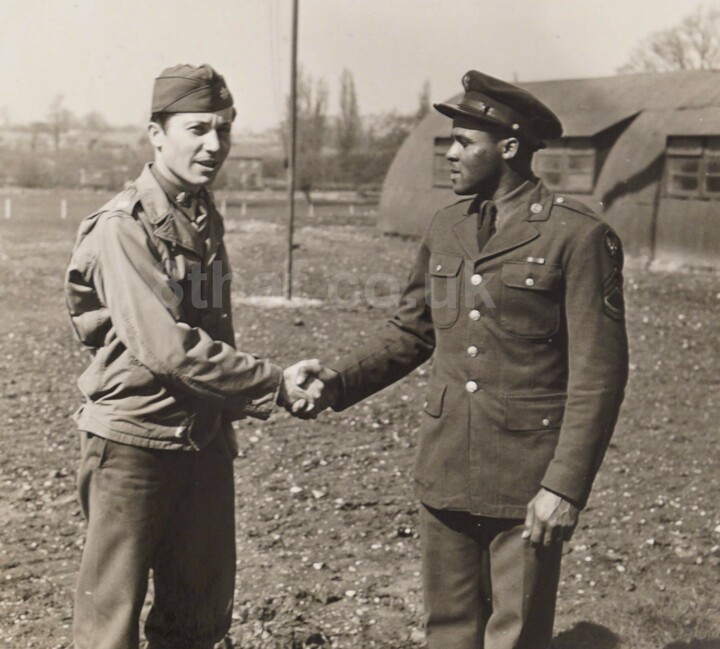



What is a Regiment, Battalion and Company?
The 923rd Engineer (Aviation) Regiment was in overall command and control of its four separate battalions (the battalions had operated independently prior to August 20, 1943). The 923rd consisted of a Headquarters (HQ) with approximately 10 officers and Headquarters and Service Company (HQ&S) with approximately 5 officers and 242 enlisted men. The HQ&S had a HQ section and further sections for administration, intelligence, drafting, surveying, operations (S-3), document reproduction, construction supply, regimental supply (S-4), utilities, heavy equipment, transportation, repair and a medical section. As some of the section names suggest, an engineer (aviation) regiment was not purely a command organisation. Many of the enlisted men were often involved directly in assigned construction work.
The four battalions (827th, 829th, 847th and 859th) were the main field formation of the regiment assigned responsibility for construction work. Each battalion had approximately 30-35 officers and typically 740-750 men (though this did reach as high as 770 at times).
Each battalion had a Headquarters Staff of approximately 10 officers, including the commanding officer, and four companies. A battalion also had a HQ&S Company (approximately 5 officers and 240 enlisted men), a Medical Detachment (approximately 3 officers and 12 enlisted men) and three Companies (A, B and C with approximately 5 officers and 175 enlisted men each). HQ&S Companies had a HQ Platoon, a Transportation Platoon, a Heavy Equipment Platoon and a Repair Section. The three lettered companies were divided into four platoons (1st, 2nd and 3rd Platoons and a HQ Platoon). The HQ Platoon in a Company covered admin and supply, the motor pool, transportation, heavy equipment and the kitchen. A company was the main unit of work assignment for the battalion.
In October 1943, the 923rd counted 162 officers and 3268 men in total with only a very few African American officers and, as the U.S. military was segregated at this time, all enlisted men were African American.
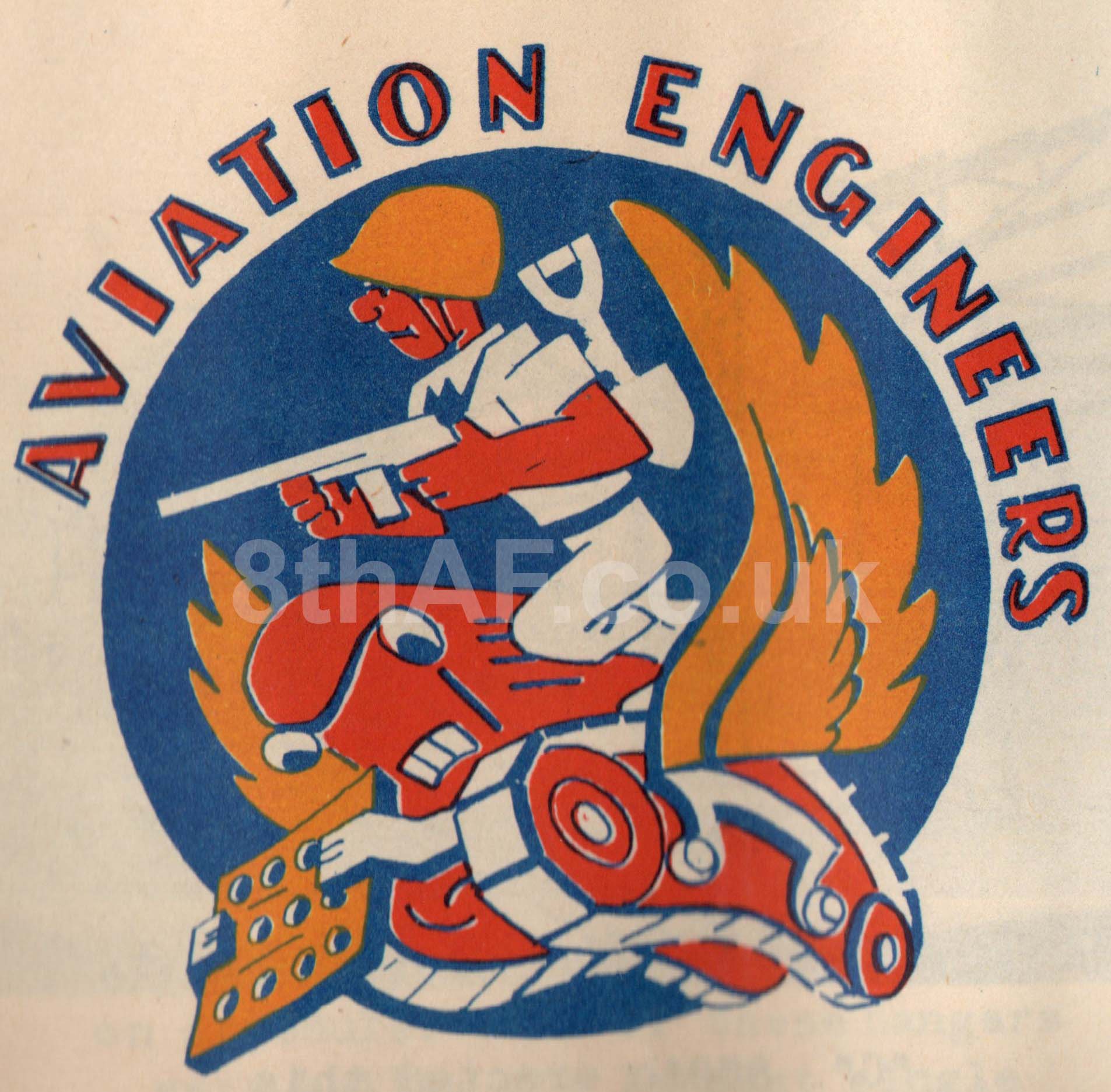
827th Engineer (Aviation) Battalion
The 827th Battalion was activated on April 8, 1942, at Hunter Field in Savannah, Georgia under the command of Capt. Dorland. Major Dam assumed command September 7, 1942, and the battalion left Hunter Field for Fort Dix, New Jersey September 20, 1942 arriving the following day. They remained at Fort Dix until December 7 when they left for the port of embarkation in Brooklyn, New York. Here they boarded the Queen Mary with thousands of other troops and sailed for the United Kingdom December 8, 1942.
The battalion arrived at the Firth of Clyde on December 14, 1942, and disembarked at Gourock, Scotland the following day. The HQ and HQ&S Company travelled directly to Eye, Suffolk (Station 134) arriving there December 16, 1942. Company A was sent to Gaddesby, Leicestershire, then Maghull, Lancashire a few days later and, finally, to Preston, Lancashire on Christmas Day 1942. They performed loading and unloading of supplies at these locations before being sent to Eye January 16, 1943. Company B was sent to Melton Mowbray for similar loading work and remained there until they headed to Eye May 12, 1943. Company C was sent to Desborough, Northamptonshire, to load and unload bombs at the nearby Braybrook Forward Ammunition Depot. They remained there until heading to Eye March 1, 1943. Capt. Bassett took command of the reunited battalion at Eye May 23, 1943. The 827th remained at Eye for the rest of 1943 to contribute to the construction of the airfield there. This was officially completed and dedicated December 7, 1943 in a ceremony attended by General Moore and the separate companies began to move on to new assignments. Major Shannon took command of the battalion February 17, 1944.
A detachment from the 827th HQ and HQ&S Company performed guard duty in Newmarket in October 1943, plumbing and building work at East Harling, Norfolk in November 1943 and were back resurfacing runways at Eye in December 1943. The 827th HQ and HQ&S Company left Eye to set up the new battalion headquarters at Weybread, Suffolk March 25, 1944 where they constructed a tented camp with asphalt floors and roads. Twenty four enlisted men from Company A performed guard duty at Newmarket, Suffolk between January 25 and February 2, 1944. The HQ&S Company, along with Company A, were sent to Bromeswell, Suffolk May 14, 1944 for seven days military training. Company A completed its work at Eye and joined the battalion at Weybread, April 4, 1944 where they were assigned repair work to the perimeter track at Thorpe Abbotts, Norfolk. This was completed and the company moved from Weybread to Framlingham to build additional hardstands for aircraft May 27, 1944.
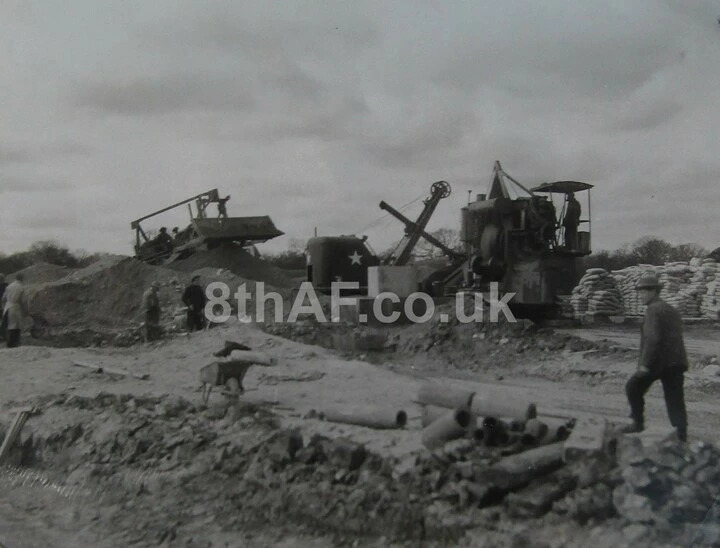
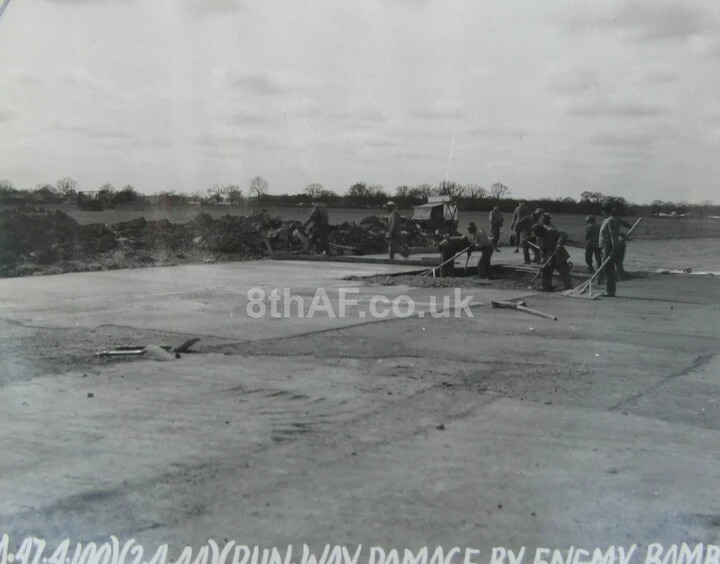
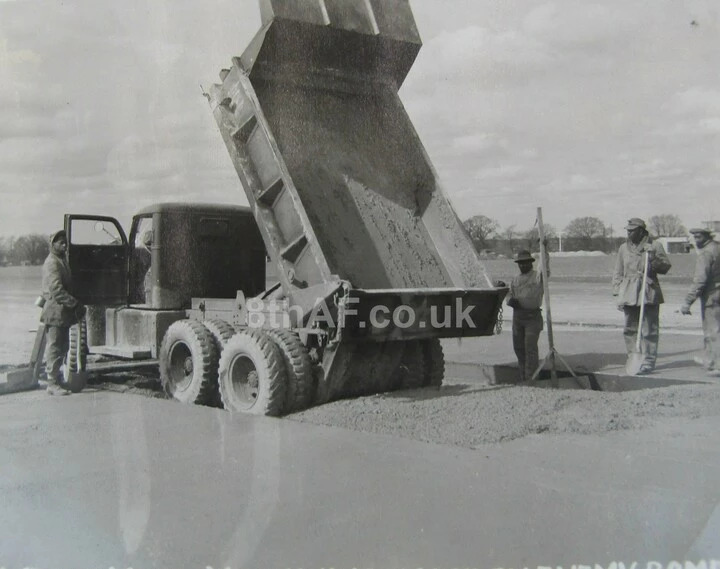
After a brief return to Weybread in early July, Company A moved to Framlingham again July 19, 1944 for recapping and repair of the runways. For one repair job they received a commendation from head of the Third Air Division, General Partridge. Late in the evening September 9, 1944, two bombers broke through the concrete on the main runway intersection. This seriously threatened bombing operations, so the company, who had already completed their shift for the day, worked through the night. They tore up a 400 foot section of runway and replaced it in twelve hours - less than half the normal time.
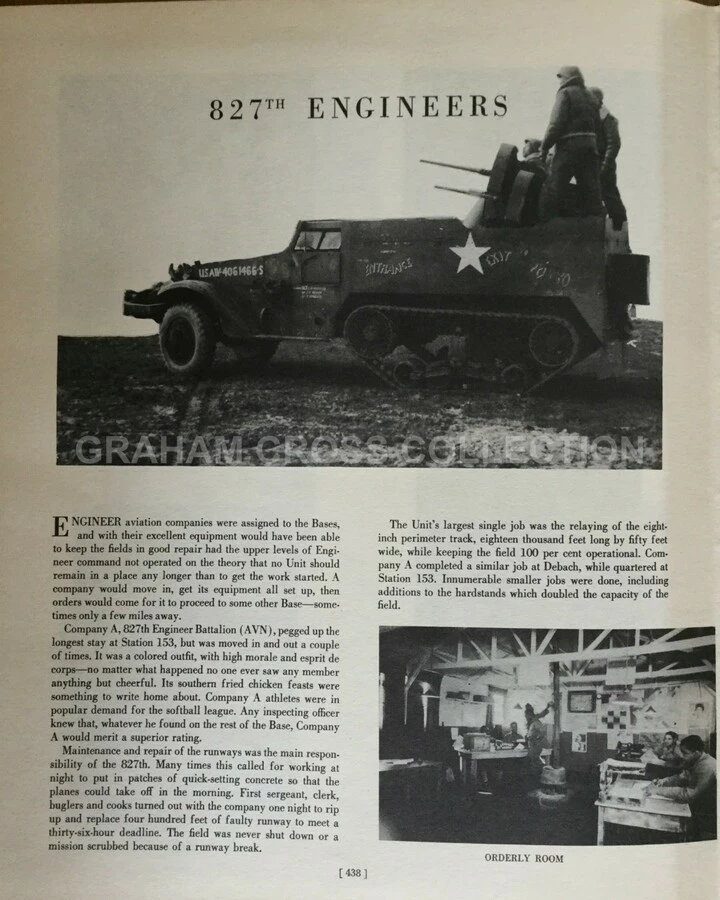

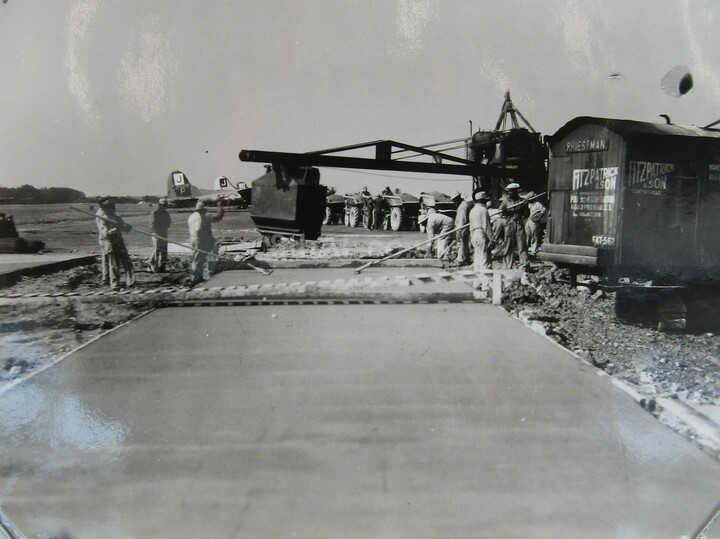
A detachment from Company B was already working on resurfacing work at Old Buckenham, Norfolk from October 24 and returned to Eye December 20, 1943. A further detachment worked on asphalting at Haughley Park, Suffolk between December 29, 1943 and February 2, 1944. The company moved to Framlingham, Suffolk to recap the perimeter track there using two 10-hour shifts on January 13, 1944. This work was completed and the company moved to Weybread, Suffolk March 12, 1944 to help run the asphalt plant there and repave the airfield at Horham, Suffolk. At the start of May, 1944, Company B, less detachments, completed seven days military training at Bromeswell, Suffolk. Company B commenced paving operations at Halesworth, Suffolk June 25, 1944 and finished September 28, 1944. They then moved to Watton, Norfolk to help with work at Shipdam airfield.
Company C moved from Eye to Weybread February 2, 1944. Their task was to run the plant at Bennett's Pits to provide asphalt for resurfacing the main runway at Thorpe Abbotts, Norfolk. This was completed March 20, 1944 and the company then began hauling asphalt on a 15-mile round trip to the airfield at Hardwick, Norfolk. Company C ran the asphalt plant at Weybread between February 1944 and July 10, 1944, producing a total of 600,000 square yards of asphalt until concrete was deemed sufficient for paving operations. At this point they began helping Company B with paving operations at Halesworth and relocated from Weybread to Watton, Norfolk September 24, 1944 to help with the recapping of Shipdam, some seven miles away (the reason stated was that this was 'the nearest available' living site).
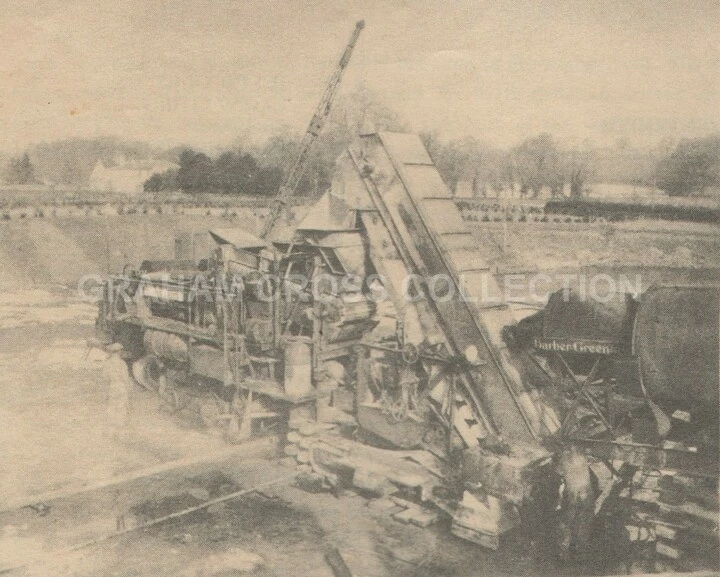
Unlike the other battalions of the 923rd, the 827th remained in the United Kingdom during its service and became a separate battalion once more when the 923rd moved to the Continent September 4, 1944. On October 16, 1944 827th Battalion HQ reported that they, and the HQ&S Company, were still at Weybread, Company A were at Framlingham and Companies B and C were at Watton, Norfolk. The third platoon (2 officers and 52 enlisted men) of Company A went to Tibenham airfield October 17 to repair the main runway and then on the Framlingham October 27, 1944. When this work was completed, they embarked on a daily round trip of sixteen miles to Debach for recapping work from November 21, 1944. Company B returned to Weybread from Watton October 22, 1944 to undertake major repairs to Bungay airfield. Two shifts were worked to replace the 20 by 15 feet concrete panels in the shortest time possible. A further task completed by Company B during November was the construction of a 1,500 by 50 feet pierced steel plank (PSP) runway at Matlask, Norfolk to allow a B-24 that had made an emergency landing to leave in a dignified manner. Company B then moved to East Wretham to construct a full length PSP runway for the 359th Fighter Group from December 12, 1944. They also widened the runway at Rackheath and built additional bomb stores at Hardwick and Bungay. Company C moved from Watton to Martlesham Heath, Suffolk November 11, 1944 to relay PSP runway and PSP hardstands and also conduct repair work on Debach airfield. There was a change of command for the battalion December 10, 1944 with the Executive Officer, Capt. Drake, becoming commanding officer. Drake was promoted to Major February 1, 1945 and remained in command until August 20, 1945.
Post-war, the battalion was used all over the south of England to begin to dismantle some of the vast war infrastructure put in place to defeat Nazi Germany. The 827th HQ and HQ&S Company moved from Weybread to Mere, Wiltshire May 18, 1945. Company A, who were still stationed at Framlingham, completed their 'commuter' work at Debach March 2, 1945. They then sent a platoon to Crookham, Hampshire May, 3, 1945 while the rest of the company moved to Andover, Wiltshire to remove PSP and prepare it for movement to a storage depot. They then moved to Membury, Devon and Thruxton, Hampshire May, 19, 1945 to perform the same task and to Crookham again June 12, 1945 to dismantle a Butler aircraft hangar. They then moved to Grove, Berkshire July 15, 1945.
Company B returned from their posting to East Wretham to Weybread February 22, 1945 and then moved to Debach to help Company A March 2, 1945. They then moved on to Eye to complete some recapping work April 1, 1945. The company then moved to Gillingham, Dorset to remove and prepare PSP for depot storage May 5, then Hawkstone Park, Shropshire June 17 and then East Harling, Norfolk, July 19, 1945 (a small detachment headed to Liverpool, Lancashire June 25, 1945).
Company C moved to Grove, Berkshire April 22, 1945 to remove PSP from Grove and Welford airfields and prepare it for deport storage. They then moved to Christchurch, Hampshire to do the same May 24, 1945. After completing their work at Christchurch they moved to Crookham, Hampshire to complete the construction of a Prisoner of War (POW) stockade and to recover timber from glider packing cases May 25, 1945. They eventually returned from Mere, Wiltshire to Watton, Norfolk June 29, 1945.
The end of the 827th's wartime deployment to England came at Wattisham, Suffolk. The battalion was notified for overseas movement to the airfield at Giebelstadt, Germany (Y-90) and attachment to IXth Engineer Command. HQ and HQ&S Company had already moved to Wattisham from Mere, Wiltshire June 29, 1945. Company A came from Grove, B Company from East Harling and Company C from Watton August 1, 1945. Company B and C were the first to leave with a 'vehicle party' sent to Southampton September 25, 1945 and the 'march' party sent there by train the same day. Both parties sailed September 27 with the 'vehicle party' reaching Cherbourg and then driving across France to Giebelstadt. The 'march' party landed at Le Havre and then took a train to the same destination. HQ and HQ&S Company left Wattisham along with Company A for Southampton in the remaining vehicles October 6, 1945. They landed at Le Havre October 9 and drove to Giebelstadt. While there, the men were transferred to the 829th Battalion prior to shipment home and the 827th, under the command of Lt. Sabe ceased its wartime existence November 20, 1945.
829th Engineer (Aviation) Battalion
The 829th Battalion was activated April 13, 1942 at Eglin Field, Florida under the command of Lt. Col. Hanburger. The battalion moved from Eglin to Fort Dix, New Jersey on August 14, 1942 and from there moved to Eye, Suffolk to construct the airfield there, arriving September 1, 1942 and then to Debach May 8, 1943. Lt. Col, Hanburger was replaced as commander of the battalion on January 4, 1944 by Lt. Col. Hallock who remained with the 829th until he assumed command of the 923rd Regiment April 16, 1944. In May 1944, the battalion moved to the Base Depot at Warton, Lancashire for rebuilding work. The battalion then moved to southern England to construct temporary airfields at Longwood, Hampshire, Barnstock, Wiltshire, Kingston Bagpuize, Oxford and Chilbolton, Hampshire. In November 1944, the battalion moved to Azelot, France and built or maintained advanced landing grounds in Europe under the command of Major Phillips.
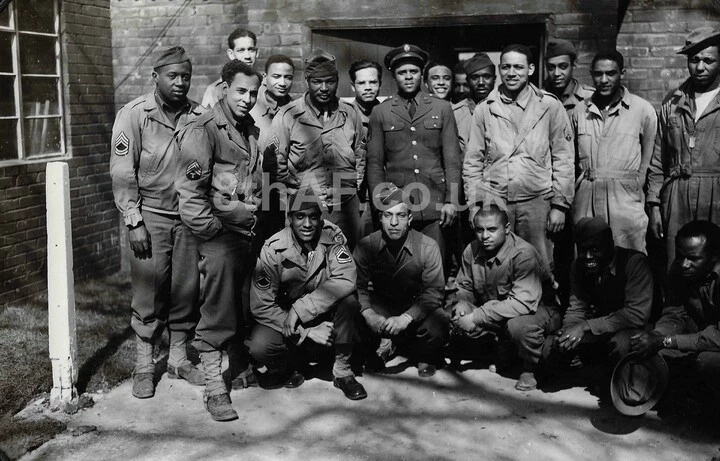
847th Engineer (Aviation) Battalion
The 847th Battalion was activated at MacDill Field, Florida October 1, 1942, under the command of Lt. Col. Hanson. A Company moved to Long Boat Key, Sarasota, Florida between March 16 and April 16, 1943, to construct a short landing strip. B and C Companies moved to Sarasota at the same time to construct a fighter runway. The full 847th Battalion left MacDill by train for Camp Shanks, New York June 4, 1943, where they prepared for overseas shipment. They left New York on the Queen Mary liner June 24 and arrived at Gourock, Scotland on June 29, 1943. After a long wait to disembark from the huge and overloaded liner, the battalion left Greenock, Scotland by train headed towards Woodbridge, Suffolk arriving there July 1, 1943. Trucks then transported them on the short ride to Debach, arriving at 17.30, where they were to assist in the completion of the airfield. The battalion was further assigned to the 923rd Regiment August 20, 1943.
In addition to their work on Debach, A Company constructed blister hangars and hardstands at Leiston, B Company constructed the firing butts, motor pool and widened roads at Framlingham and C Company constructed a tented camp and administrative offices at Stowmarket. After the completion of Debach in May 1944, A, B and HQ and Service Companies of the battalion moved to Oakley Park, Suffolk (C Company moved directly to Tibenham, Norfolk). Here they were responsible for the maintenance of airfields at Thorpe Abbotts, Tibenham, Hethel, Bungay, Horham and Eye. A problem had arisen with British six-inch concrete crumbling under the weight of American heavy bombers. The solution, carried out between May 10 and July 18, 1944, was to provide an eight-inch concrete overlay as an emergency repair with much of the work carried out while some of the bombers were away on a 'shuttle' mission to Russia. C Company completed similar work at Tibenham between July 11 and September 1, 1944, at Hardwick July 25 to October 10, 1944, and Bungay September 4 to October 10, 1944.
On October 15, 1944, the battalion boarded a train at Diss and moved to Weymouth Harbour where A, B and HQ and Service Companies boarded a Landing Craft Infantry (LCI) while C Company went to Portland and boarded a Landing Craft Tank (LCT). Bad weather then delayed their crossing of the Channel until October 21 and they finally landed at Omaha Beach on October 22, 1944. The battalion drove to Orly and then Dijon, arriving October 28, 1944. Here they repaired the airfield while A Company moved on to Lyon where they worked to extend the airfield runway. Lt. Col. Hargett took command of the battalion on December 26, 1944, as the battalion followed the Allied advance into Germany. Sadly, the battalion lost eight men during wartime service, five of them in a tragic truck accident on the N-40 Highway near Frankfurt May 19, 1945.
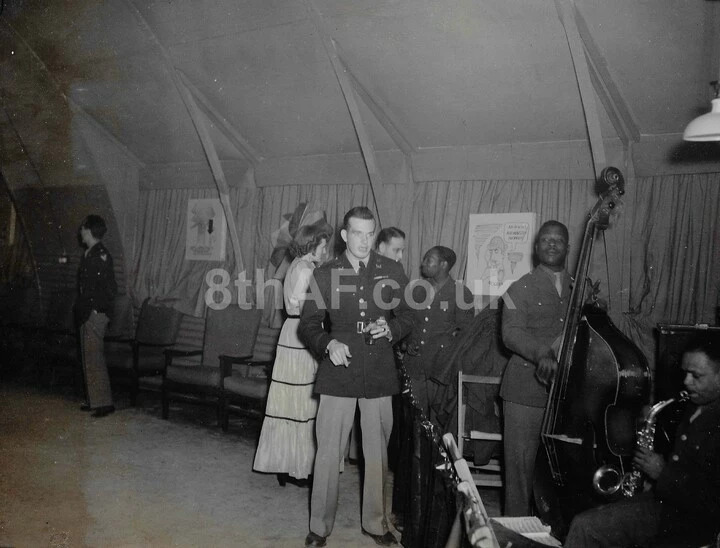
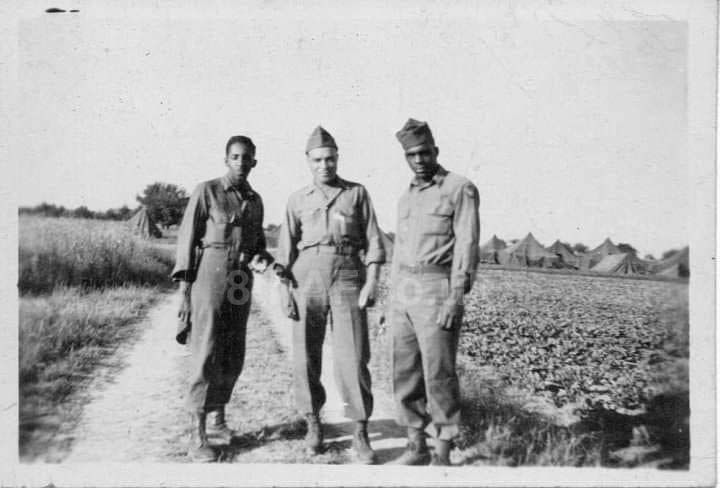
(Guitano Family Collection)

(Guitano Family Collection)
859th Engineer (Aviation) Battalion
The 859th Battalion was activated at Eglin Field, Florida on August 1, 1942 under the Command of Major Houghton R. Hallock. On May 5, 1943, the battalion boarded the liner Queen Elizabeth at Camp Kilmer, New Jersey arriving at Glasgow on May 12 and at Eye, Suffolk the following day (Company B was sent to Melton Mowbray to work on an ammunition dump and Company C, under Lt. Pfeil, was sent to Penistone to load bombs on trucks). At Eye, the 859th assisted the 829th to complete the airfield beginning work at 0700 hours May 14, 1943 (only 16 days from leaving Eglin). Headquarters and Service Company busied themselves pouring concrete for the runway (in addition to their administrative work) while Company A worked on buildings and other airfield structures. The airfield at Eye was finished and dedicated by December 7, 1943 and the success and efficiency of Lt. Col. Hallock in commanding the battalion was, no doubt, noticed as he was transferred to command the 829th Battalion January 4, 1944 and then the 923rd Regiment on April 16, 1944. Lt. Col. Miller took over command of the battalion at that point. From then, the battalion worked on providing asphalt overlays for perimeter tracks, laying concrete and airfield maintenance across the region. From June to August 1944, the battalion moved to Watton in Norfolk to lay a concrete runway (over 23,000 cubic feet of cement) and construct or repair many buildings (B Company was sent to work at Gt. Saling, Stansted and Gosfield). On November 8, 1944, the battalion moved by motor transport to Southampton and boarded HMS Mecklenburg for the journey to France. They anchored at Le Havre on November 9 and eventually disembarked at Rouen on November 11, 1944. The battalion went to Toul and constructed a fighter-bomber airfield in just six days during poor winter conditions. The battalion then moved to Frankfurt in July and finally Schweinfurt in September 1945.
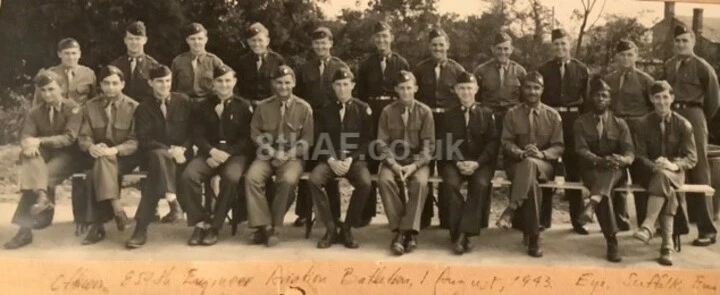

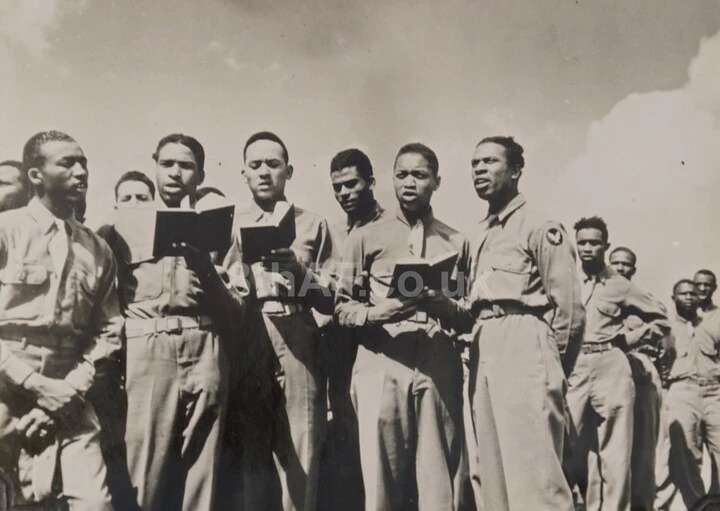
Eye Airfield
The construction of Eye Airfield (Station 134) began with the arrival of the 829th Engineer (Aviation) Battalion under the command of Lt. Col Hanburger September 1, 1942. The first work was grubbing out hedgerows and the construction of Nissen huts (though B Company were sent to Wortley, South Yorkshire to unload ordnance on September 25 and A Company went to Cinderford, Gloucestershire between late September and early December 1942 to carry out similar work). By November 24, 1942, the remaining elements of the battalion at Eye had constructed a 500-foot by 40-foot section of runway. By late January 1943 they had poured concrete for the perimeter track, built housing and graded roads, but on May 8, 1943, the battalion was sent to Debach to help with construction work there.
The Headquarters and Headquarters and Service Company of the 827th Engineer (Aviation) Battalion commanded by Major Dam arrived at Eye December 16, 1942. The other Companies were not stationed at Eye until A Company arrived January 16, 1943, C Company arrived March 1, 1943, and B Company arrived May 12, 1943. The 827th specialised in laying concrete for the airfield and remained there until the station was completed December 7, 1943. B Company then left for Framlingham January 13, 1944, C Company left for Weybread, Suffolk February 2, 1944, followed by the Headquarters and Headquarters and Service Company March 23, 1944. A Company remained at Eye finishing off remaining jobs until April 9, 1944, when they too headed for Weybread.
The 859th Engineer (Aviation) Battalion under the command of Lt. Col. Hallock were also heavily involved in the construction of Eye. The Headquarters and Headquarters and Service Company, along with A Company (20 officers and 407 enlisted men in total) arrived at Mellis Junction Station at 05.30am May 13, 1943. They were picked up by trucks driven by the 829th and taken to Eye where they began work at 07.00am the following day. Headquarters and Service Company poured cement while A Company began constructing buildings. Companies B and C joined the battalion at Eye July 14, 1943. The 859th concentrated largely on building Nissen and Romney huts, a watch tower, sick quarters, link trainer, bomb trainer, photo block and T2 Hangars, the latter completed in February 1944. Although the airfield was declared completed in a ceremony on runway No. 2 attended by Brig. Gen. Cecil Moore December 7, 1943, there still remained a good deal of work to complete. Capt. Miller took command of the battalion when Lt Col. Hallock transferred to the 829th battalion January 3, 1944. The airfield was declared officially operational March 31, 1944, the first in the European theatre completed entirely by African American troops. In early April Companies B and C went to Debach to assist the completion of the airfield there while Headquarters and Headquarters and Service Company of the battalion went to Haughley Park, Suffolk (B and C Companies joined them there April 28, 1944, as work at Debach was largely completed). A Company left Eye May 23, 1944, and went directly to Watton, Norfolk to begin expansion and refurbishment work on the airfield there.
The 923rd Engineer (Aviation) Regimental Headquarters was also located at Eye from August 22, 1943, when nine officers and 244 enlisted men arrived. Regimental Headquarters remained at Eye until March 16, 1944, when the 23 officers and 244 enlisted men moved to Haughley Park, Suffolk.
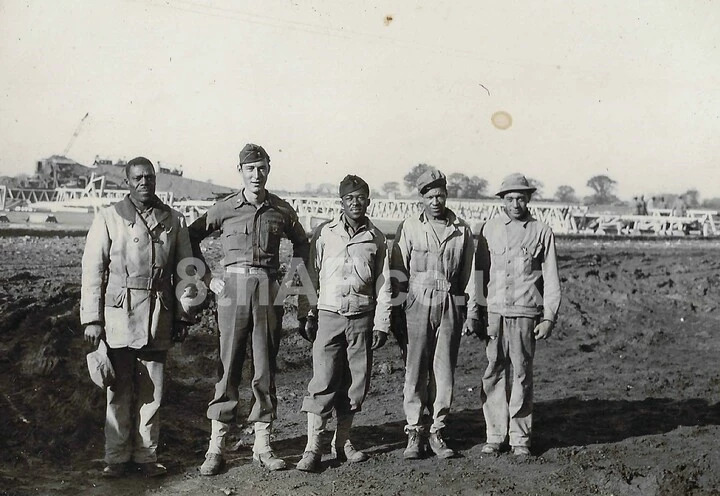
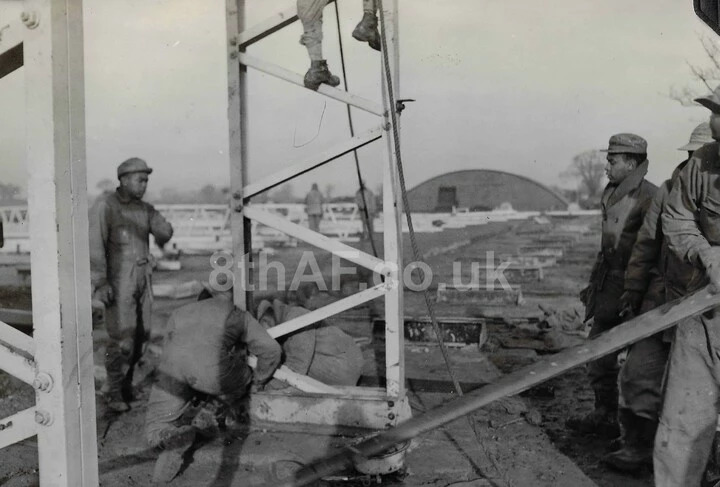
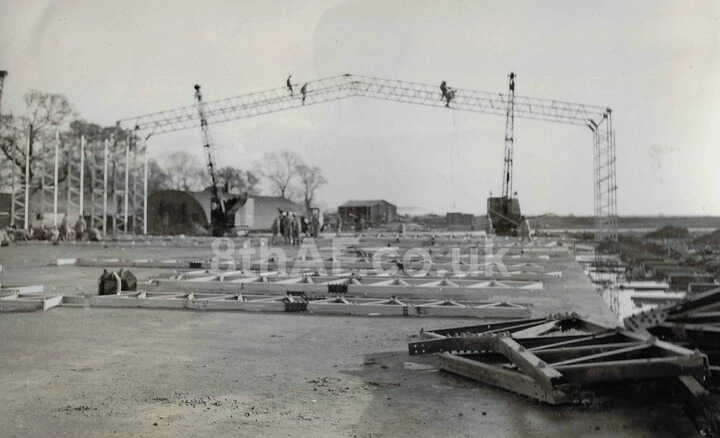
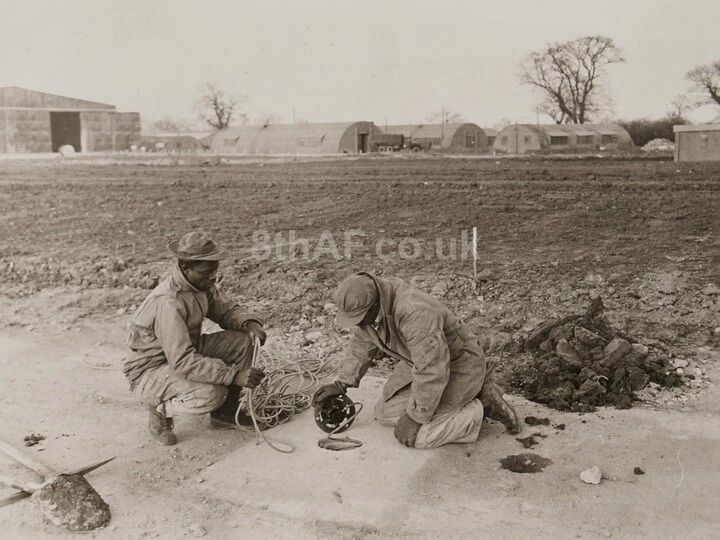
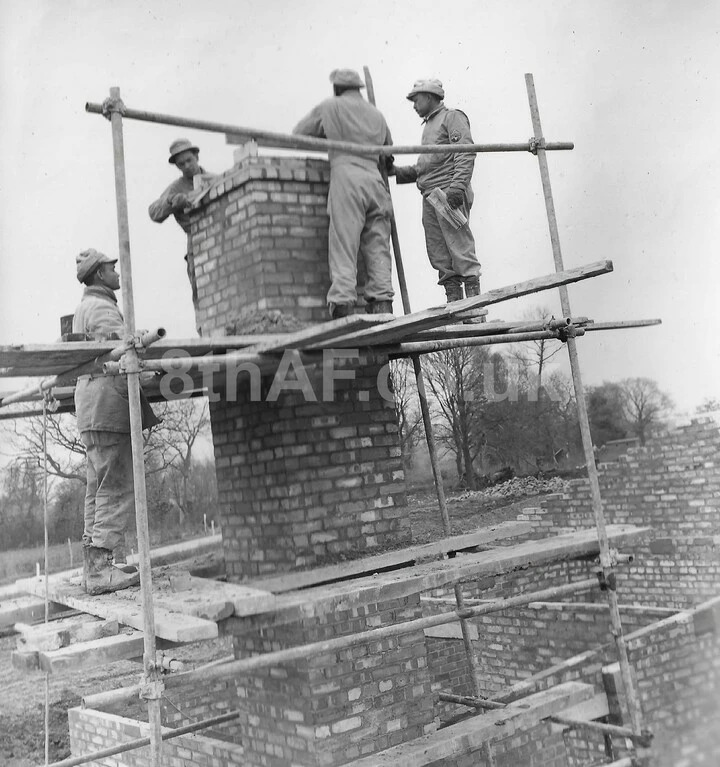
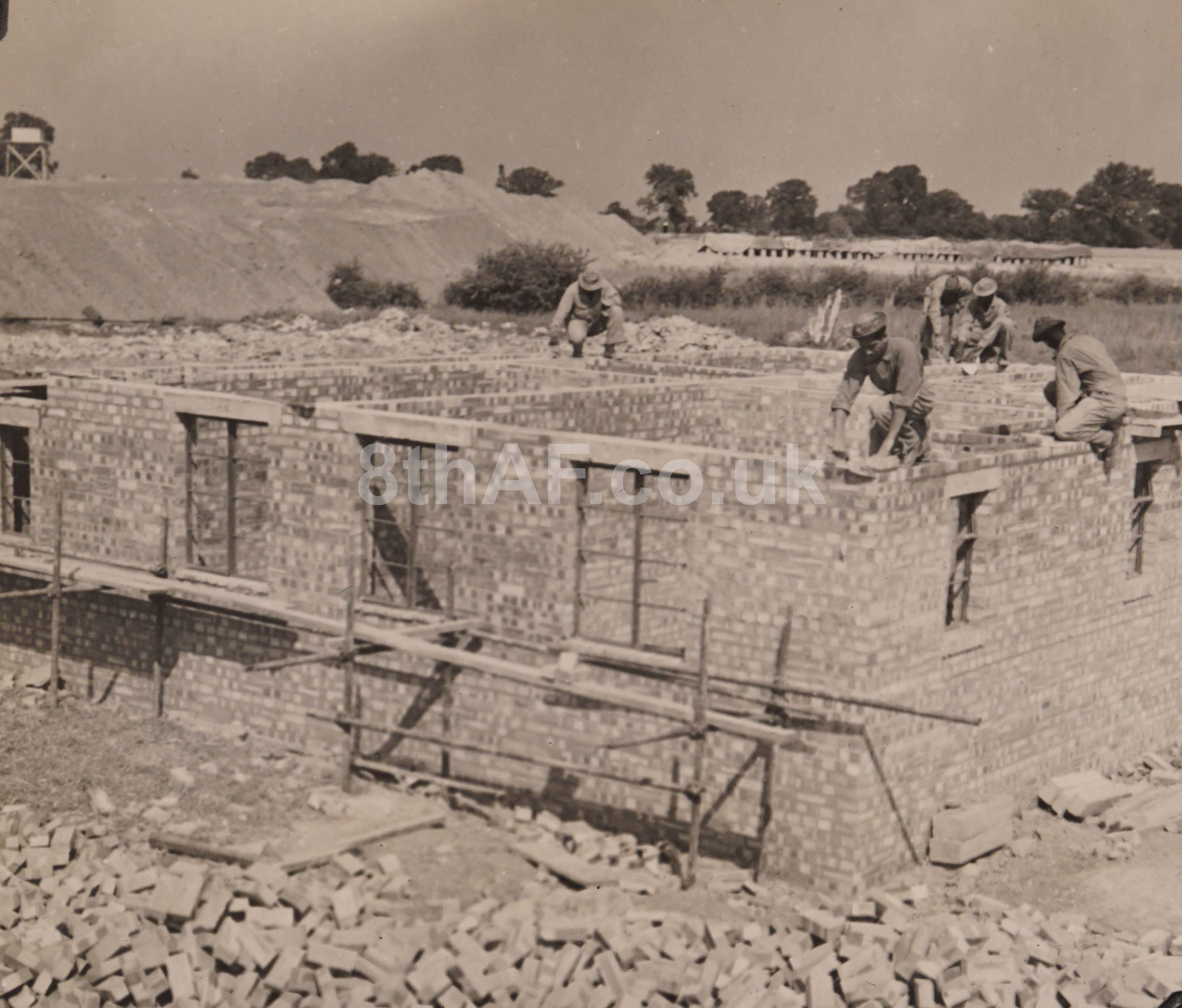
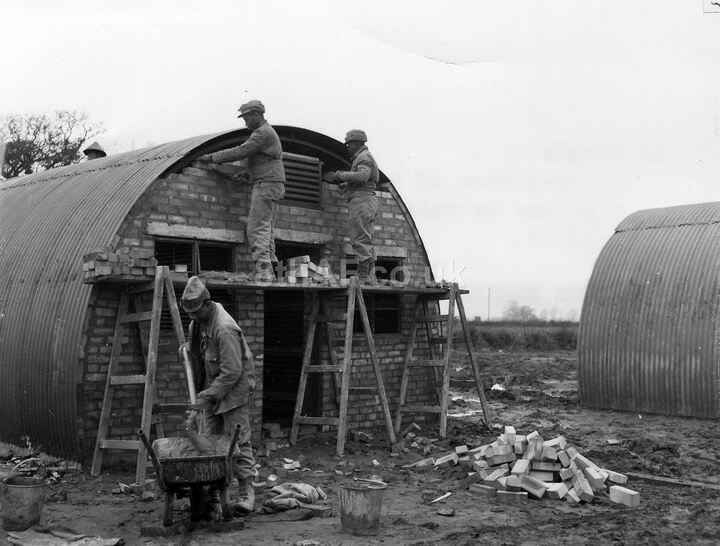
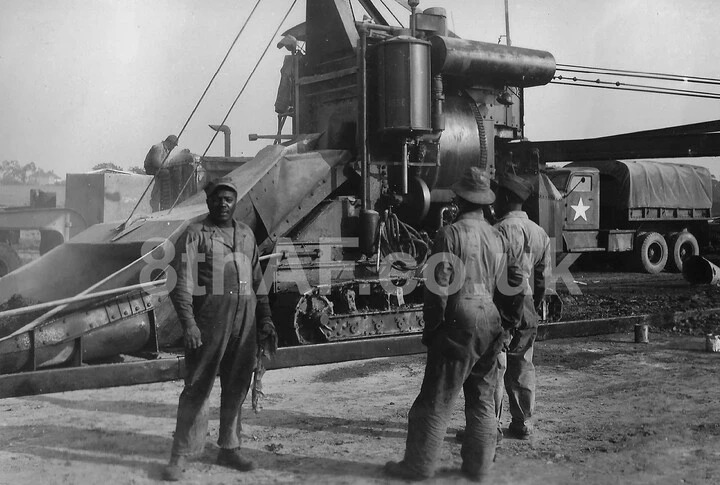



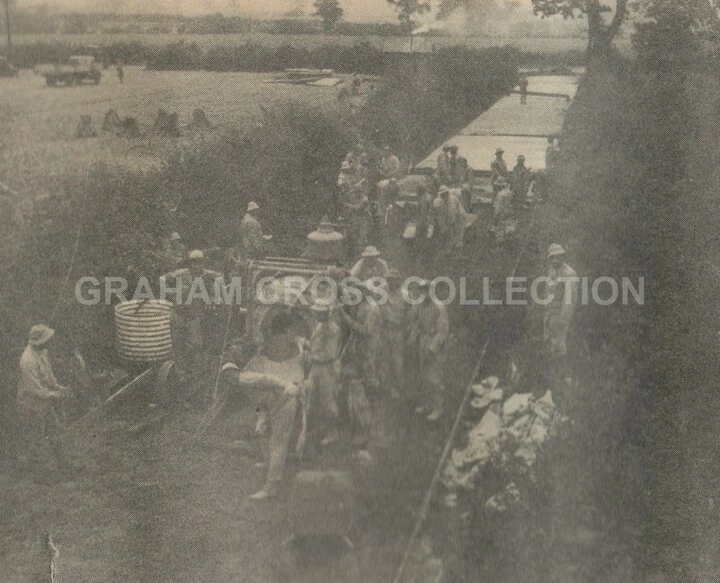
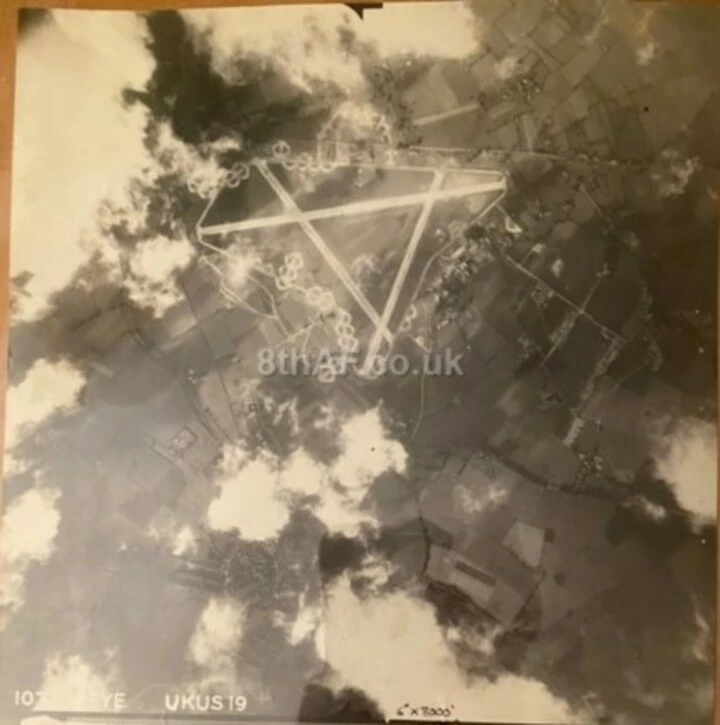



Debach Airfield
Construction of the airfield at Debach (Station 152) was begun by the 820th Engineer (Aviation) Battalion. The 820th was a white unit that had among its members Robert Arbib, the author of Here We Are Together. They had completed approximately 26.8% of the construction work with runway No. 1 and No. 2 complete. Runway No. 3 was partially complete and about one third of the perimeter track had been laid. A substantial start on the construction of the living sites had also been made.
The 829th Engineer (Aviation) Battalion, commanded by Lt. Col. Hanburger, relocated from Eye May 8, 1943, and instituted a system of two ten-hour shifts to advance the construction work. This successful measure resulted in the runways and perimeter tracks being completed by July 1, 1943. Lt. Col. Hallock took command of the battalion January 3, 1944, and remained in place until taking command of the 923rd Regiment in April 1944. Major Hargett took command of the battalion April 15, 1944. The major achievements of the 829th at Debach included the construction of 90,000-gallon aviation gas store, a 72,000-gallon petroleum store, bulk oil and motor transport installations, laying 17,400 feet of water mains, pouring 271,700 yards of concrete for the perimeter track and hardstands and building 36 brick buildings, two steel huts, two Romney Huts, two SECO Huts and 155 Nissen Huts.
The 829th were joined by the 847th Engineer (Aviation) Battalion July 1, 1943. They arrived at Woodbridge Station and were picked up in trucks driven by the 829th, arriving at Debach at 17.30 hours. The 847th contributed to the perimeter track and hardstanding work and built hospital site buildings, living accommodation, the mess site and cinema, the technical site, bomb dump and control tower. They also installed the French drains, sewage disposal system and power lines. B and C Companies of the 859th Battalion were briefly at Debach in April 1944, but quickly moved on as the work was largely completed by that stage.
The airfield was dedicated at a special ceremony attended by the 829th and 847th May 1, 1944, though the first B-24 Liberator to land at Debach did so exactly one month prior to this on April 1, 1944. Company A of the 829th moved on to Martlesham Heath May 4, 1944, Company B moved on to Framlingham May 9, 1944, and the Headquarters and Headquarters and Service Company also moved to Martlesham May 12, 1944. Companies A, B and the Headquarters and Service Company of the 847th moved to Oakley Park, Suffolk on May 2, 1 and 3, 1944, respectively. The 847th Headquarters moved to Oakley Park May 6, 1944. C Company of the 847th went directly to Tibenham, Norfolk May 7, 1944.

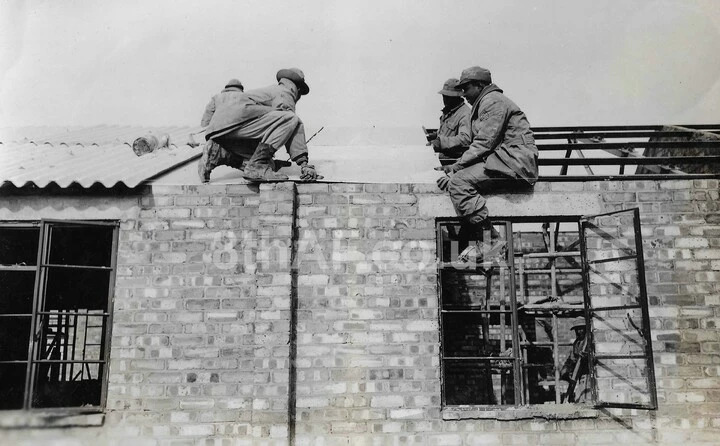
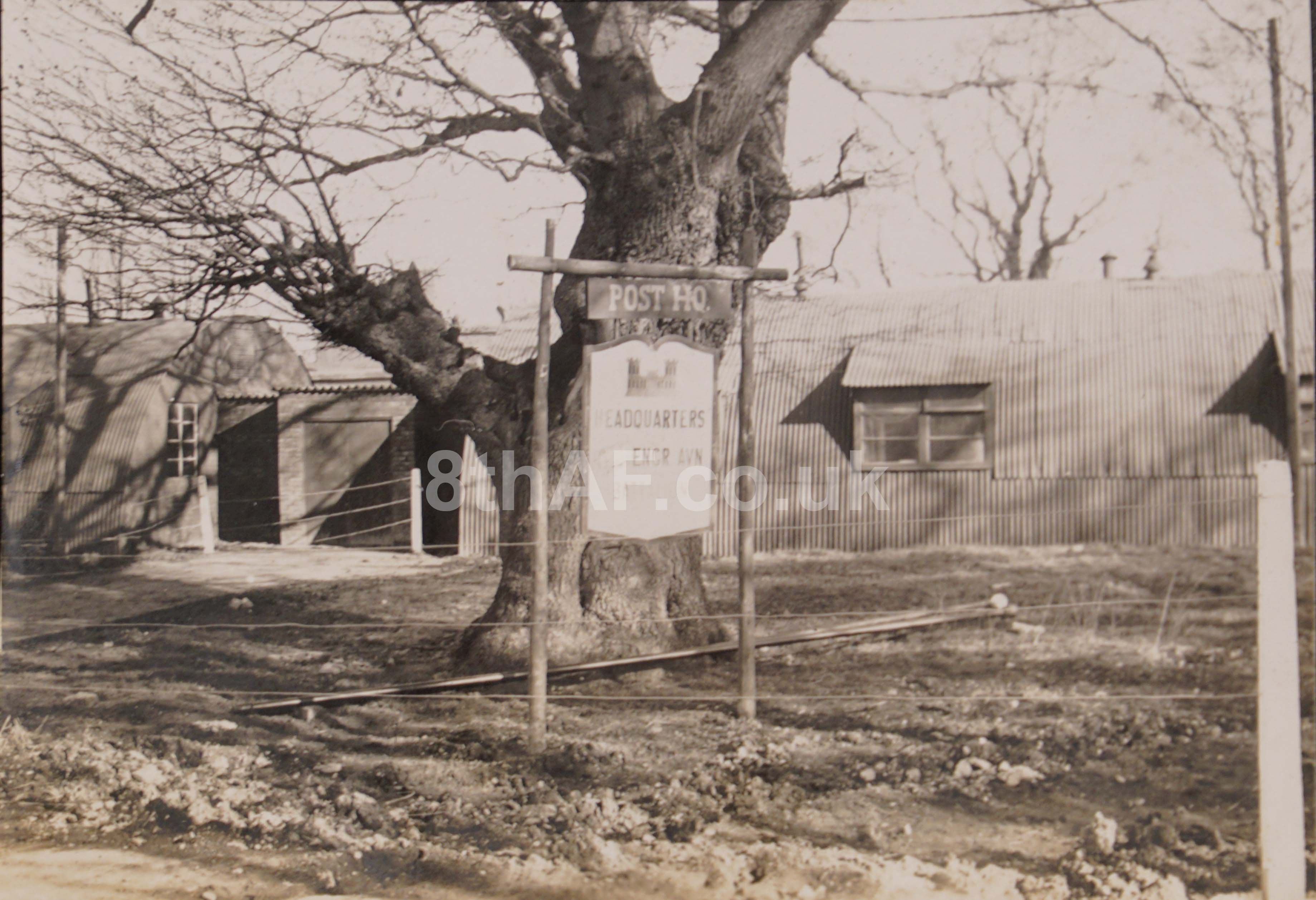
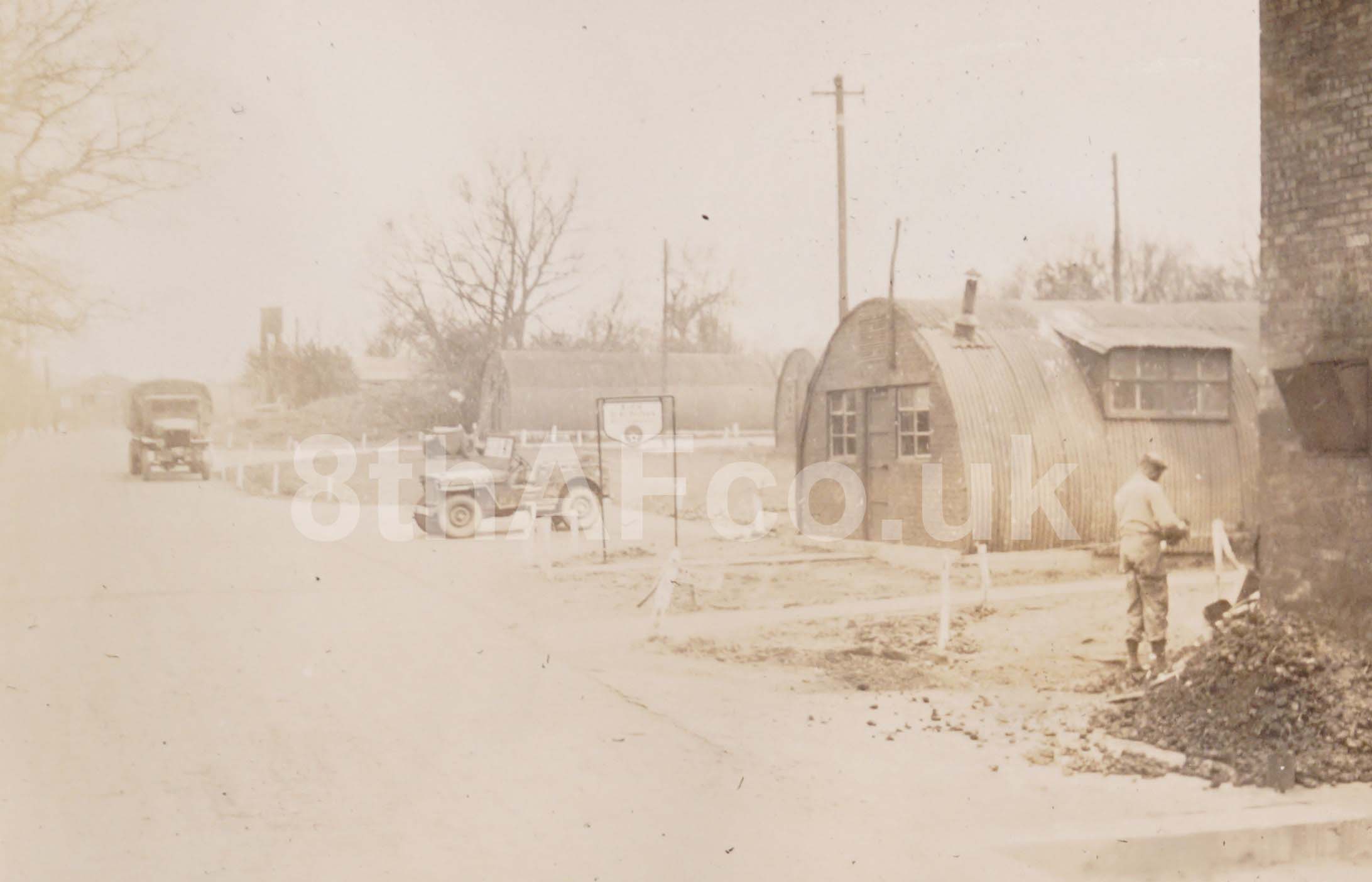
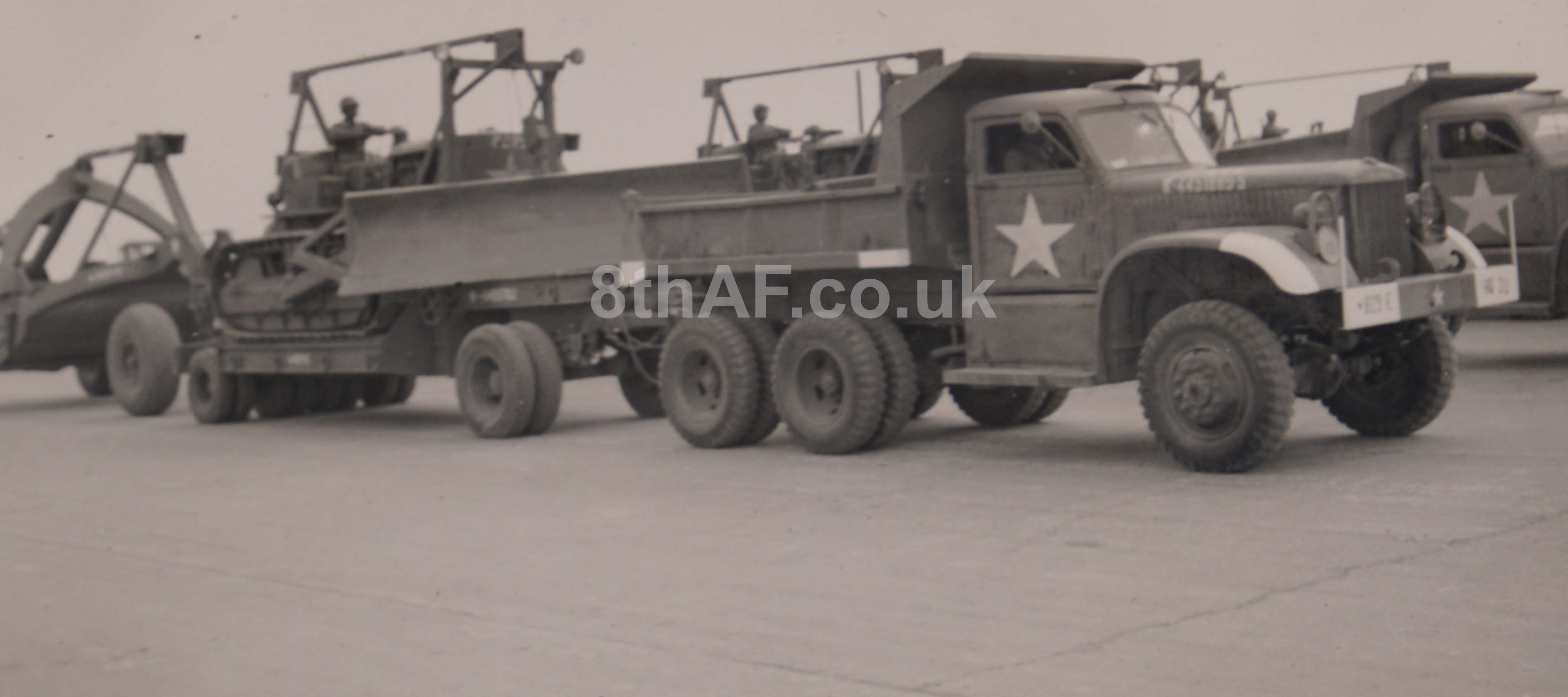

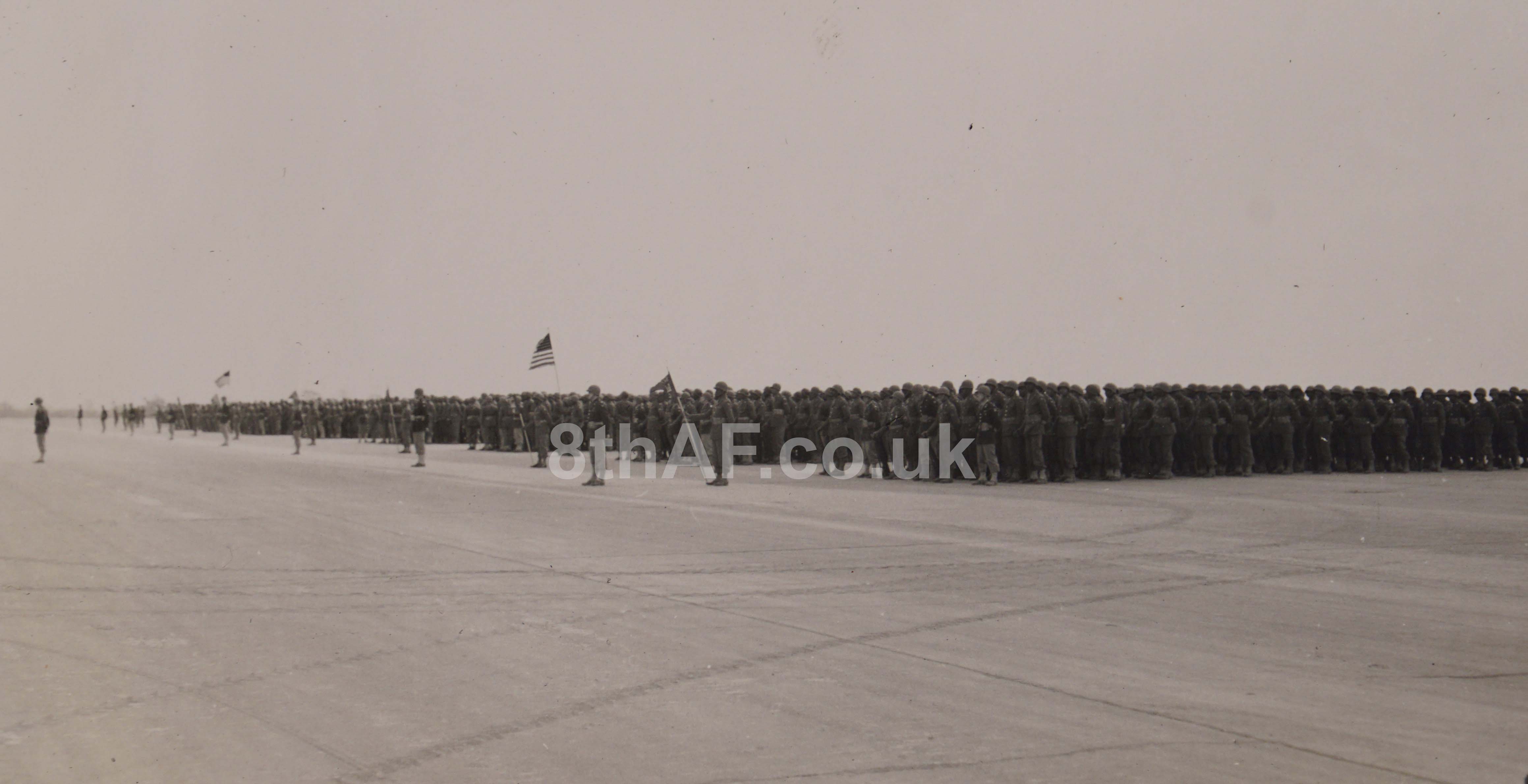
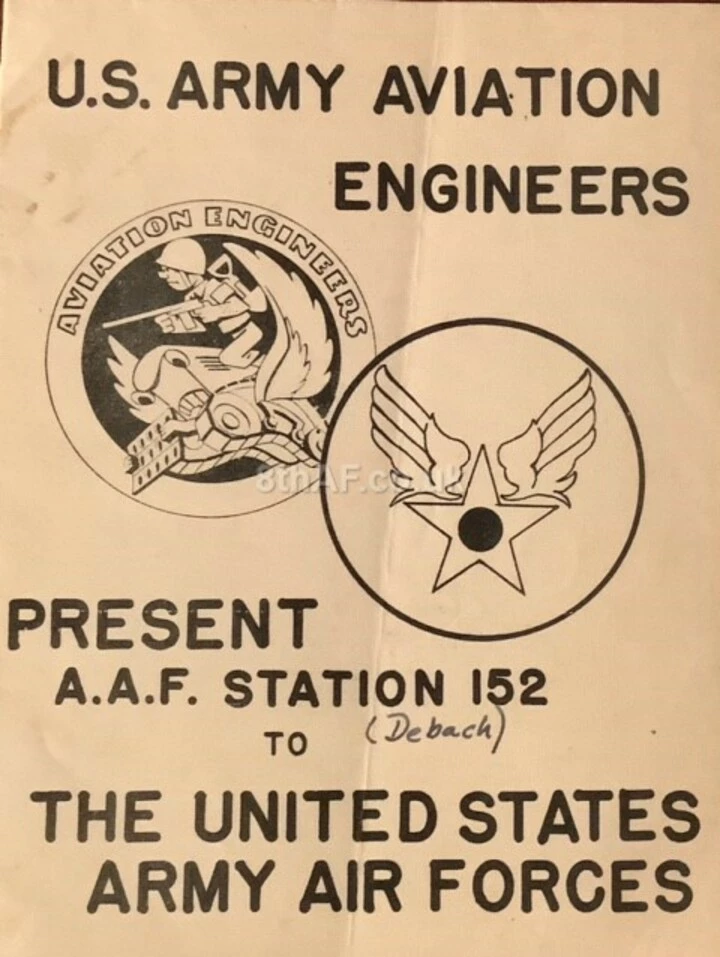


Music and Song
The 923rd Engineer Aviation Regiment contained many talented performers. Their music and song proved very popular with both American forces and the British and European people.
The 'Negro Chorus'
The U.S. Army Public Relations Office decided in summer 1943 to set up a ‘Negro Chorus of 200 Voices’ from the 923rd Engineers. Noted African American Tenor Roland Hayes travelled to Britain to sing with them in a number of concerts, including several performances at the Royal Albert Hall in September 1943. The Chorus then went on tour to Manchester, Glasgow and Edinburgh during October 1943 to great acclaim before the men's duties called them back to work.


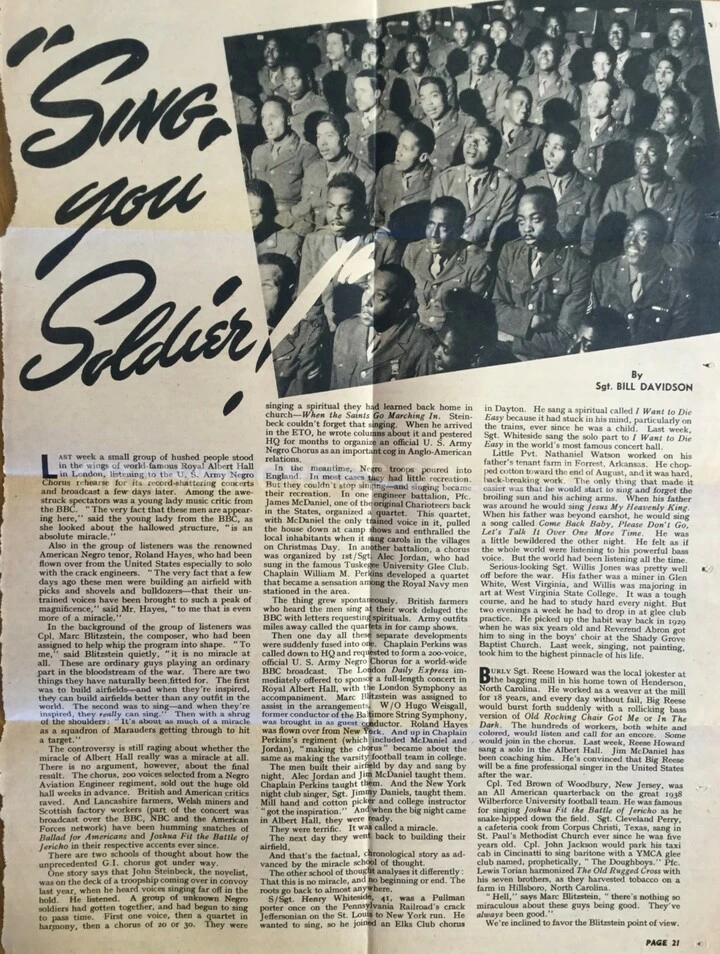
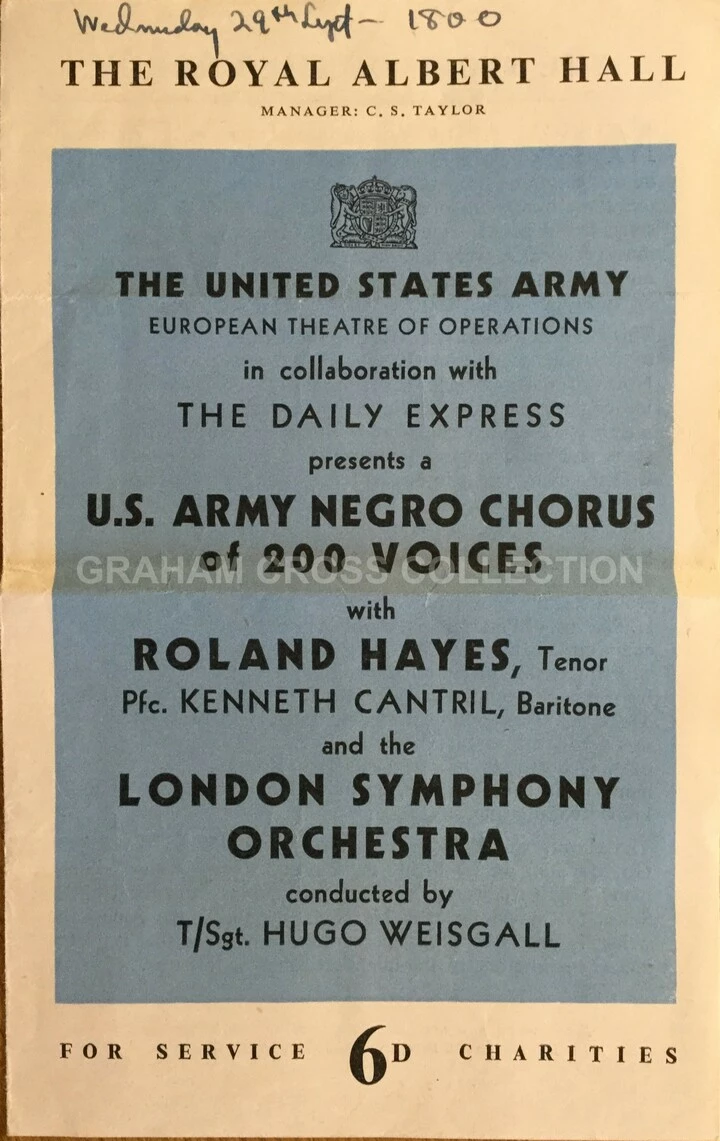
This film taken of the 'Chorus' in Vittel, France in late 1944 gives a flavour of their performance.

923rd Performers and Bands
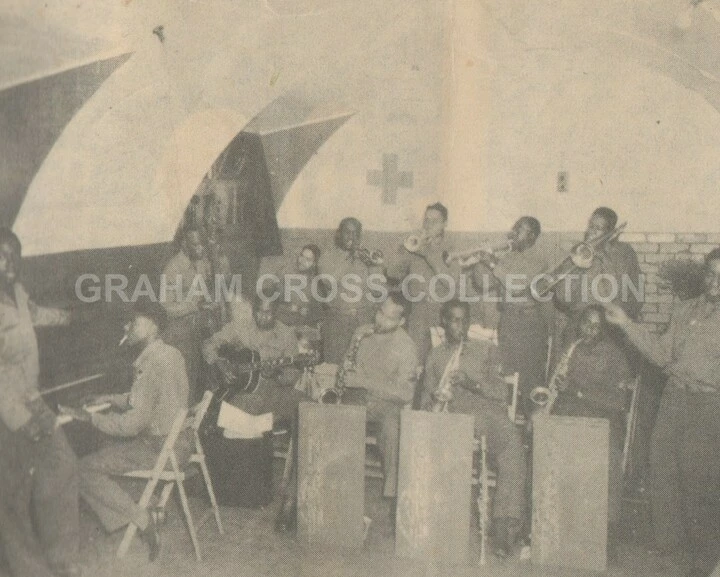

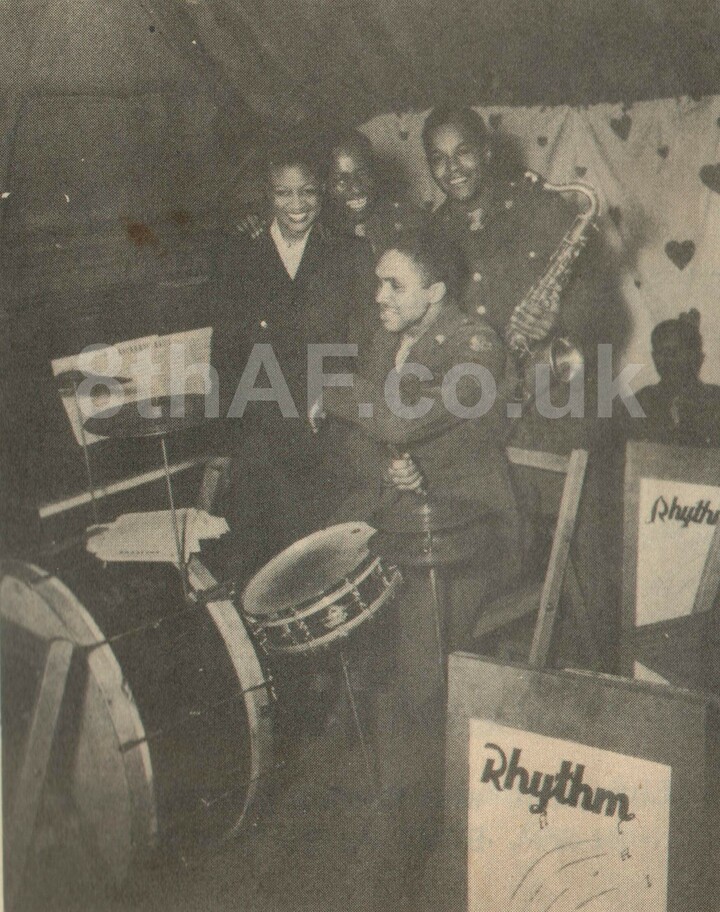
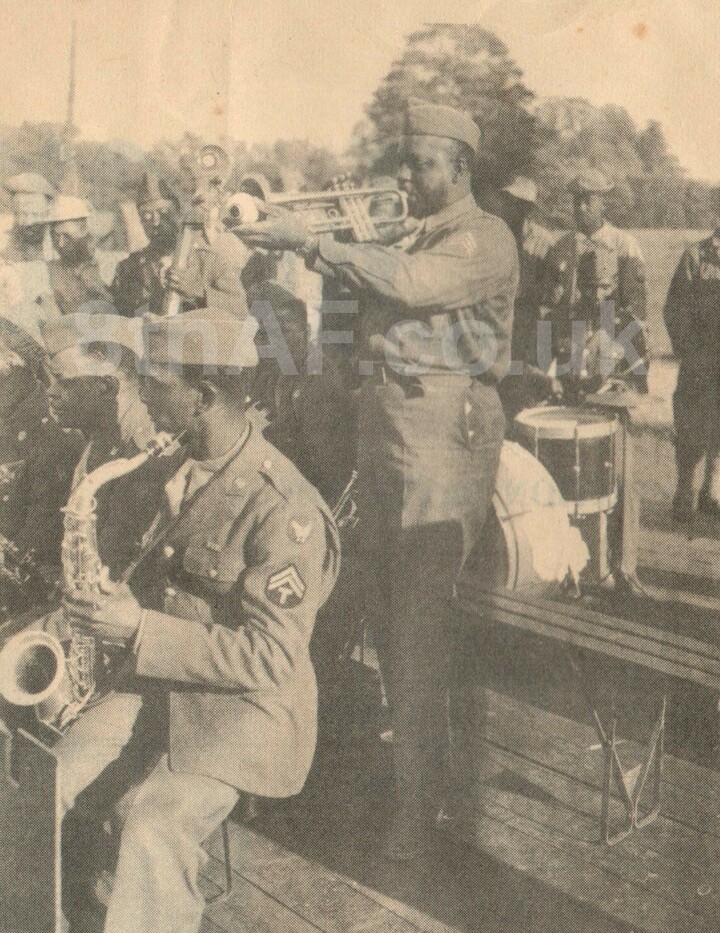
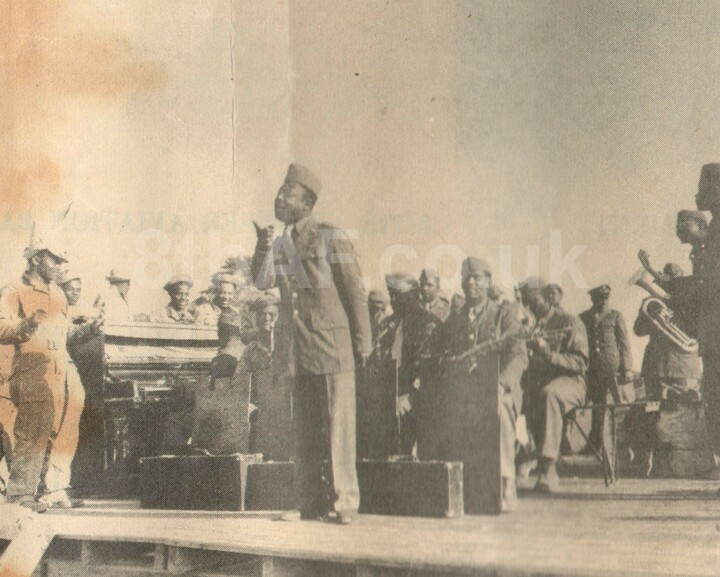
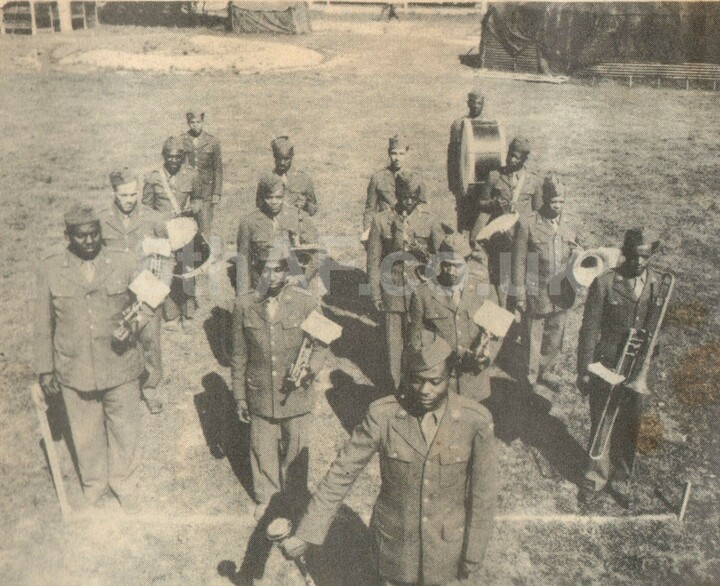
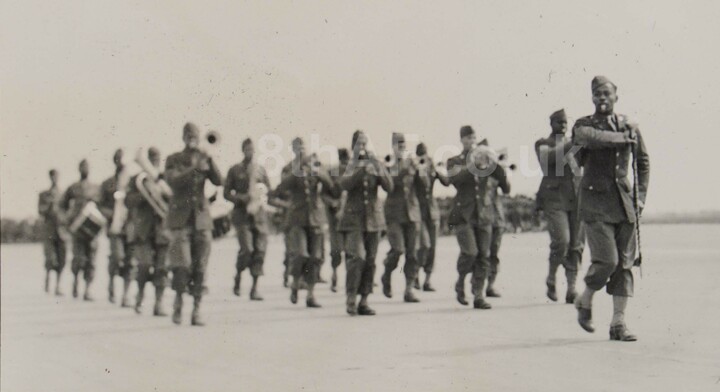


Visits from World Boxing Champion, Joe Louis
The World Heavyweight Boxing Champion, Joe Louis, enlisted in the US Army during World War II. He served as a Private in the Special Services Division until promoted to Technical Sergeant in April 1945 and participated in recruitment, war bond sales campaigns and troop morale tours. In England during 1944, Louis actually visited the 923rd twice - the first time flying into Debach for the official handover of the completed station in May 1944 and then again for 'Joe Louis Day' at Haughley Park, June 11, 1944.
Debach
On May 1, 1944 a completed Debach airfield was officially handed over to the 8th Air Force represented by Major Gen. Curtis LeMay (then head of the Third Air Division and who later commanded U.S. bomber forces over Japan). Major Gen. Cecil R. 'Dinty' Moore, then the Chief Engineer presented the airfield (at point 0.19 in the film - Moore is identified wearing the spectacles). The film cameras were on hand to record the proud display by the men of the 829th and 847th Battalions. Col. H. R. Hallock (then commanding officer of the 923rd) is driving the Jeep in the film (at point 1.54 to 2.06) with Gen. Moore seated next to him and Gen. LeMay behind him. The other passenger is Col. Vollmar.
At the start of the film, the solider receiving the medal is T/Sgt Hardy who was presented with the Legion of Merit by Gen. Moore as part of the ceremony (the scene runs from the beginning to point 0.18 in the film). The Legion of Merit was an award given to those 'who have distinguished themselves by exceptionally meritorious conduct in the performance of outstanding services.'
The famous boxer, Joe Louis also arrived to help the Regiment celebrate its achievement. You might note the B-17 Flying Fortress in the film - this was the first aborted attempt to bring Louis to Debach that was foiled by misty conditions. He was later brought in by a transport plane seen in the staged shots at the end of the film for the benefit of the cameras.
'Joe Louis Day,' Haughley Park, June 11, 1944
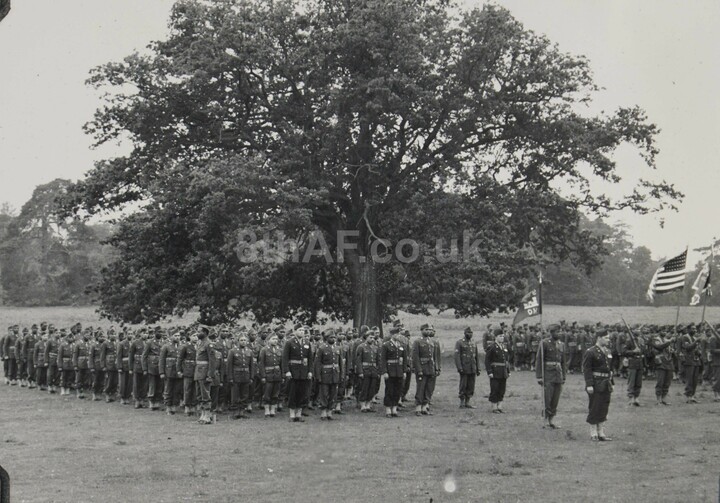


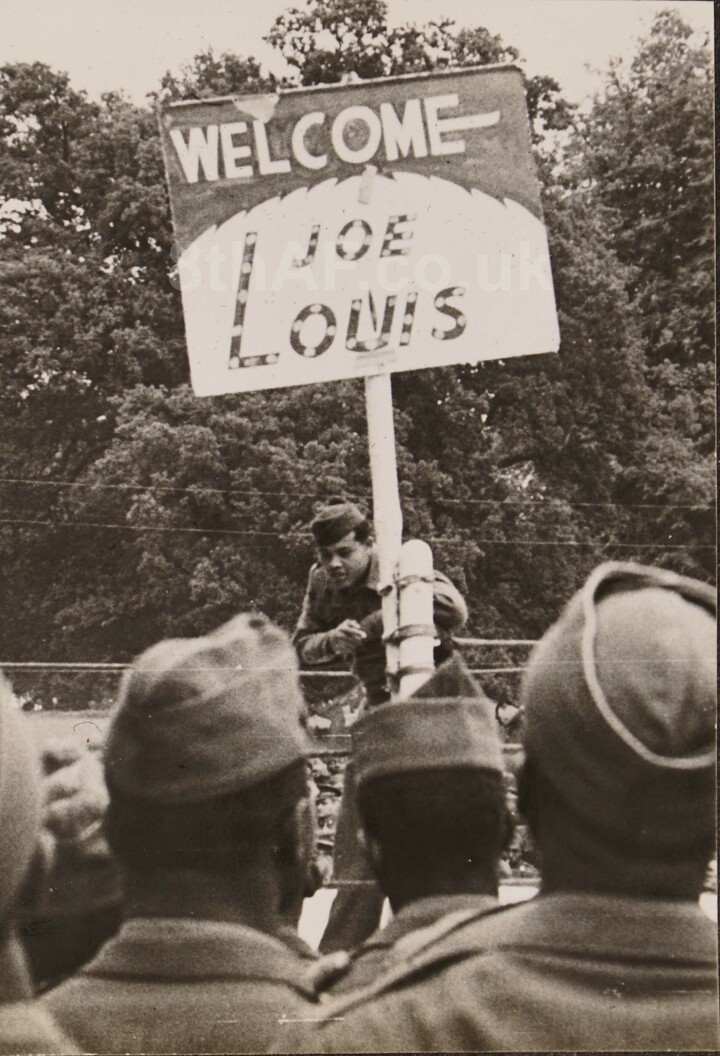
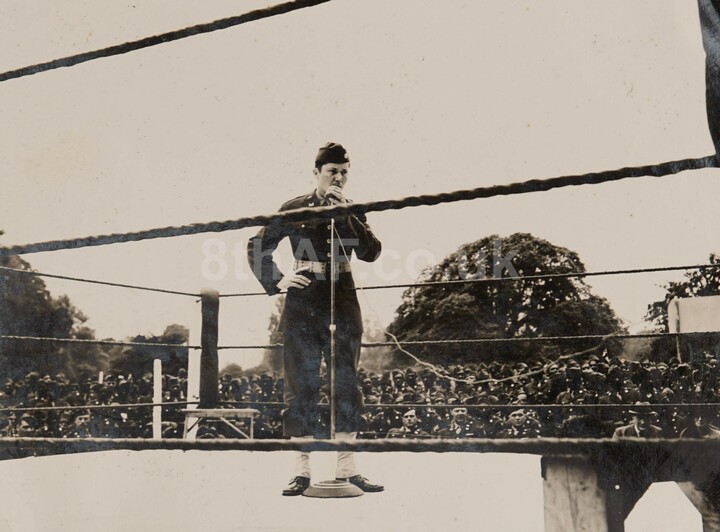
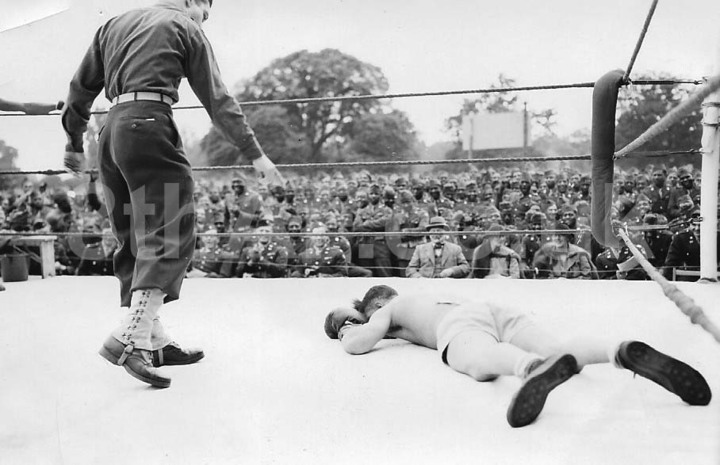
On to Europe and Home
This 923rd (less the 827th Battalion) moved to Europe in late 1944 to support the 1st Tactical Air Force and then IXth Engineer Command. Their work involved repairing damaged airfields for Allied use and creating new landing strips with pierced steel planking (PSP). This film shows the 829th Battalion working on a new temporary landing strip and gives a good idea of a typical day of work for the men. The film cuts (at point 5.02) to the Choir at Vittel film posted above. (Posted/credit to ixengineercommand.com)
